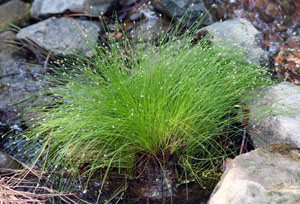
Fiber optic grass is a fun plant (even though it isn’t really a grass) that most people acquire because of its unusual appearance. Isolepis cernua (=Scirpus cernuus), in the sedge family (Cyperaceae), is a variable evergreen species with a mop-like tuft of fine green stems. It is found in wet places, growing as a marginal water plant or in sandy or peaty areas near the sea in its native range of western and southern Europe, the British Isles, North Africa, the west coast of North America (California to British Columbia and Alaska), and Australia and New Zealand.

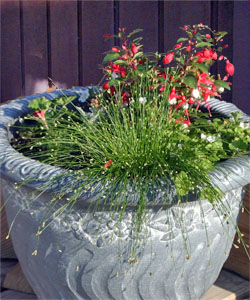
This bright green, grass-like plant has small flower spikes at the stem tips reminiscent of those fiber optic lamps, hence the common name (it doesn’t change colors like the electric version, though). It is sometimes marketed as “Livewire”, “Live Wire” or “Fairy Lights”. These easy-to-grow plants grow upright as a young plant and then gracefully droop as they mature. The 10-12” clumps of fine, glossy, hair-like leaves can reach a spread of 20″ at maturity. The foliage may yellow as temperatures drop in fall or turn brown if the plant doesn’t receive enough moisture.

Tiny flowers are produced on the tip of each leaf. The cone-shaped terminal inflorescences begin a white or silver color, but eventually turn tan or brown. The plants will bloom year-round.
I. cernua is a tender perennial (zones 8-11) generally grown as an annual in cold climates but it can be kept as a houseplant in a sunny window or greenhouse over the winter. Bring it indoors before freezing temperatures occur and set the pot in a shallow tray of water.
Fiber optic grass grows best in full sun with plenty of moisture. Do not allow it to dry out or the foliage will turn brown. It can be planted in containers, in the ground, or kept in a water garden or pond. It will tolerate some shade but will become lankier under those conditions.
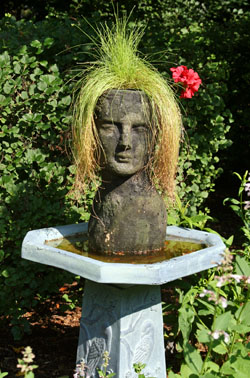
Grow these plants as specimens to show their unique character, or plant as accents among other plants grown for foliage or flowers. Combine it with other moisture-loving annuals in boxes or pots, or grow it in its own container in a grouping of potted plants. Try it as an underplanting with dark-leaved elephant ears (Colocasia esculenta ‘Black Magic’ or other cultivars). Place it on the edge of borders or beds, or between rocks at water’s edge drooping over or into the water. For a novelty conversation piece, use it to top a “head” container! The fine texture of this plant is a good contrast to plants with coarse leaves, and its mounded habit is a good foil for upright plants and spiky flowers. Fiber optic grass is a good addition to container water gardens.
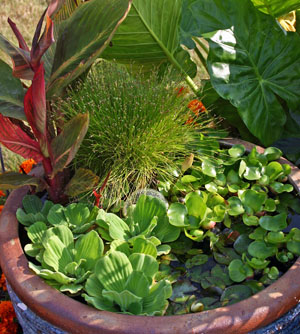
If you plan to use this plant in a water garden, gradually increase the water level it sits in unless you purchased it from an aquatic plants display. This will allow the roots to become accustomed to being submerged. In a water garden it combines well with horsetails (Equisetum), dwarf papyrus, and cannas (but it best to keep each in separate pots). It can be planted on the water’s edge or in the shallows of ponds, positioned so that the water level is no more than 2” above the soil. The leaves trailing in the water will provide shelter for frogs and fish.
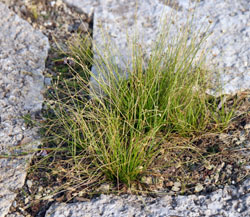
I. cernua is easy to grow from seed (and will readily self seed under the right conditions) but is faster and easier to propagate vegetatively. Divide when it outgrows its container. Just chop it into pieces and replant. It is best to do this only in spring if the plants are to be overwintered outdoors.
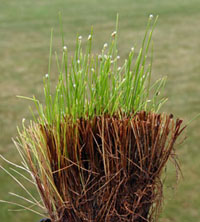
If it gets too long and lanky, give it a haircut and it will grow right back. If you cut plants back to a few inches after dividing them in the spring, they will likely quickly put out new growth. Avoid shearing in winter when the plant is not growing, however. This plant has few pest problems and is resistant to deer. Mealybugs may infest it indoors if not submerged in water.
– Susan Mahr, University of Wisconsin – Madison
Ask Your Gardening Question
If you’re unable to find the information you need, please submit your gardening question here:





 Marigolds
Marigolds Create a Butterfly Garden
Create a Butterfly Garden Plant Flowers to Encourage Beneficial Insects
Plant Flowers to Encourage Beneficial Insects Forcing Bulbs
Forcing Bulbs


